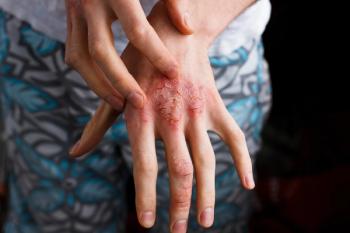
Can antibacterial fabrics help manage atopic dermatitis?
Clothing is a secondary skin and can influence the severity of skin conditions such as atopic dermatitis. But the antibacterial effectiveness of specialized clothing used to reduce disease symptoms varies considerably. Researchers recently decided to put these fabrics to the test - here's what they found.
Clothing is a secondary skin and can influence the severity of skin conditions such as atopic dermatitis. But the antibacterial effectiveness of specialized fabrics in reducing disease symptoms varies considerably, and clothes that use such material do not modify Staphylococcus aureus (S. aureus) skin colonization – unless they are moistened, says research published in Dermatology Research and Practice.1
It is well-known that smooth fibres such as silk and cotton are gentler on the skin, and that patients should avoid clothing made from scratchy fabrics such as wool as they may exacerbate the condition. This insight has led to the development of textiles that claim to reduce the intensity of atopic dermatitis by modulating the skin staphylococcal profile via an antibacterial activity. The fabric itself often has metallic silver or silver compounds deposited in or onto synthetic fibres of the fabric, while some use zinc or quaternary ammonium as antibacterial agents.
Most clinical trials that have looked at the use of antibacterial clothes for treatment of atopic dermatitis have reported improvement in symptoms or reduced itching, but a systematic meta-analysis study of these trials highlighted that the evidence was low quality,2 and noted that while patients had mostly assessed the clothing positively, it was unclear if this was due to an antibacterial effect, the use of smooth fibres or a combination of both.
German researchers recently compared the antibacterial effectiveness of five conventional functional clothes for atopic dermatitis treatment by quantitative international standard suspension tests. They then used a real-life setup of affected atopic dermatitis skin using S. aureus colonised artificial skin, to assess if functional clothes are effective under practical wear conditions.
The five cloth sample fabrics were: Lyo-Zinc which consists of 74% lyocell, 19% SmartCell sensitive fibre, and 7% spandex; Silk-Aegis, a pure form of silk consisting exclusively of fibroin and containing a finish of AEGIS AEM 5772/5, an insoluble colorless, odorless ammonium as antibacterial; PA-Silver, a micromeshmaterial of 82% polyamide, 18% lycra with woven silver filaments with a silver content of 20% in total (130 g/m2 ); Smart-Zinc consisting of 70% Supima cotton, 18% lyocell, and 12% elasthane; Modal-Silver made of 79% modal, 14% silver yarn, and 7% lycra (210 g/m2).
In the standard suspension tests, samples differed considerably in their antibacterial effectiveness, with silver and zinc endowed fibres outperforming AEGIS endowed silk fabrics. In the real-life setup simulating dry skin microenvironment, all samples failed to reduce S. aureus.
Dirk Höfer from the Hohenstein Institute for Textile Innovation, Bönnigheim, Germany, says, “None of the samples displayed a significant antibacterial activity after a wear period of 4 h and 18 h when the clothes were worn at a realistic skin microenvironment, that is, relative humidity of 50% and in close contact with the inoculated skin.”
When the samples were wetted to their individual water absorption capacity and left on the skin for 18 h, the zinc-containing fabrics (Lyo-Zinc and Smart Zinc) displayed stronger antibacterial activities than the silver-containing samples made of modal and polyamide.
“This observation supports the fact that moisture is needed to release a sufficient amount of contact biocide from antibacterial fibres,” Höfer says, but he adds. “In terms of the dermatological point of view, wearing of wetted atopic dermatitis clothes is unrealistic in real life that would hardly be tolerated by atopic dermatitis patients.”
Moisturisers are emphasized as a basic part in the treatment of atopic dermatitis to enhance the healing and to prolong the clinical improvement after discontinuation of anti-inflammatory therapy, and reduce the need for subsequent topical corticosteroids. However, there has been no data available on if and how functional clothes and fibre types interfere with moisturisers.
“The presumed antibacterial effect of functional clothes might actually be disturbed by the simultaneous use of moisturising creams. On the other hand, cream remnants might cling to the clothes, mitigating the severity of eczemas,” Höfer says.
The interaction of the five sample with a moisturising cream was therefore evaluated during a real wearing situation and after domestic laundry. Absorption of moisturising cream was found to be dependent on the particular fibre type of the fabric and domestic laundry was unable to completely remove the cream.
It has been speculated that antimicrobial clothes might at least partly modify the skin microbiome through the enhancement of the activity of topic pharmaceuticals Рthat is, by prolonging the pharmaceutical effect Рor by reducing scratching and itching, H̦fer says.
“This view is supported by the observation within this study that the silk sample displayed no antibacterial effect at all, but absorbed a significantly greater quantity of the moisturising cream.”
References:
1. Höfer D. A Real-Life Based Evaluation of the Effectiveness of Antibacterial Fabrics in Treating Atopic Dermatitis. Dermatology Research and Practice vol. 2018, Article ID 7043438, 8 pages, 2018. https://doi.org/10.1155/2018/7043438.
2. C. Lopes, D. Silva, L. Delgado, O. Correia, and A. Moreira, “Functional textiles for atopic dermatitis: a systematic review and meta-analysis,” Pediatric Allergy and Immunology, vol. 24, no. 6, pp. 603–613, 2013.
Newsletter
Like what you’re reading? Subscribe to Dermatology Times for weekly updates on therapies, innovations, and real-world practice tips.


















